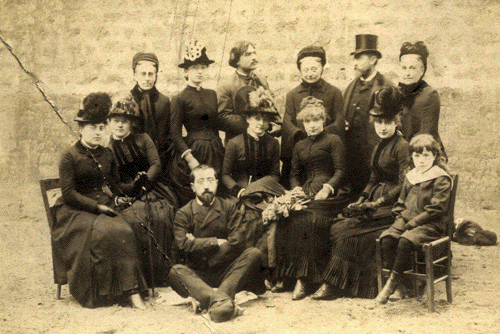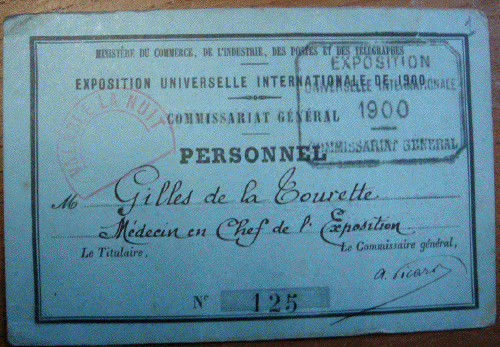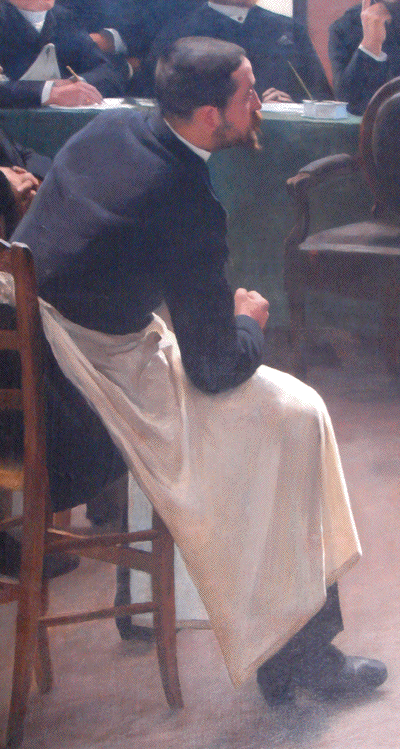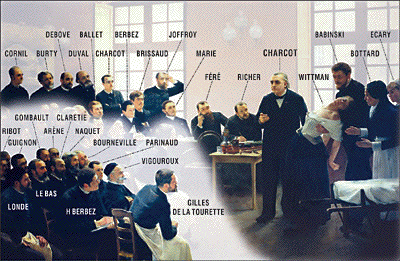 - interne de JM. Charcot en
1884
- © Extrait
de l'Album de l'internat de La
Salpêtrière conservé
à la Bibliothèque Charcot à
l'hôpital de la
Salpêtrière
- (Université
Pierre et Marie Curie, Paris)
-
- Georges Gilles de la Tourette, a neurologist
and prolific medical writer at the end of the
19th century belonged to a group of students
closest to Jean-Martin Charcot (1825-1893).
Charcot writes in a preface: "Gilles de la
Tourette says that he contented himself with
explaining my teaching and organising my works
and those of my pupils. It is the first time he
has forgotten he is one of my pupils, and one of
the best. He does not mention his own works,
which are of the highest importance in their
domain." Maurice de Fleury, also known as Horace
Bianchon (1860-1931), would say: "Charcot likes
and values his pupils only in direct proportion
to the work they produce under his direction,
and for him." Gilles de la Tourette would be the
most prolific of his pupils.
-
- Georges Gilles de la Tourette was born on 30
October 1857 in a small village near Loudun in
west-central France. He was the first of four
children. His father was a merchant but belonged
to a family of physicians. Georges lacked
discipline and had a difficult character with
unpredictable mood swings. He was peculiar, but
exhibited a keen intelligence.
-
- He enrolled in medical school in Paris at
twenty years old, three years after having begun
his studies at the medical school in Poitiers.
In 1881, he became an "interne" (house officer)
at the Paris public hospitals. He counted Paul
Brouardel (1837-1906) and Alfred Fournier
(1832-1914) among his teachers. In 1884, he
started studying under JM. Charcot (1825-1893),
rapidly becoming one of his favourite pupils,
advancing to "chef de clinique" (specialist
registrar) for two years (1887-1888).
-
- Although it is not clear why, Gilles de la
Tourette was interested in chorea well before
meeting Charcot. Indeed, as early as 1881, he
translated the 1880 historical paper by the
American physician Georges Beard (1839-1883) on
the Jumping Frenchmen of Maine. The translation
was published in the Archives de Neurologie
without any annotations in French. As noted by
C. Lajonchere et al. (1996), Gilles de la
Tourette took liberties in his translation and
misrepresented the original material. JM.
Charcot encouraged his pupil to persist in these
studies; Gilles de la Tourette explains: "On the
advice of our teacher, Professor Charcot, we
have ourselves analysed the works of the three
earlier authors (Beard, O'Brien, Hammond),
demonstrating in July 1884 that Jumping
Frenchmen of Maine, Latah in Malaysia and
Myriachit, observed by American officers in
Siberia, were one and the same condition". De
Fleury writes: "Charcot provides the ideas, his
students provide the scientific building
materials which he controls and centralises. But
there is no way he would forget a service
rendered: whoever works for him is rewarded one
hundred times over." Charcot rewarded Gilles de
la Tourette by giving his name to the first
disease he described. This first description
appeared in 1885 in Les Archives de Neurologie:
"Etude sur une affection nerveuse
caractérisée par de
l'incoordination motrice accompagnée
d'écholalie et de coprolalie" (Study of a
nervous condition characterised by motor
incoordination accompanied by echolalia and
coprolalia), in which he included the
observation of the Marquise de Dampierre,
initially published by J. Itard (1774-1838) in
1825.
-
- We need to notice that his article was
published one year before he defended his
doctoral dissertation in 1886. Except for one
occasion in 1899, when another clinical case was
described in La Semaine Médicale, G.
Gilles de la Tourette never again studied
convulsive tic disorder. In the Semaine
Médicale of 15 September 1886, Charcot
clarified the distinction between chorea and
convulsive tic disorder, writing: "We have
proven that these people have what I would call
a particular form of mental alienation...". "We"
may mean "Gilles de la Tourette and I", but may
also be the emphatic "we" meaning "I",
indicating Charcot's significant role in this
description. But given that "his"
anatomical-clinical method had not been used,
since these patients had no detectable
neurological lesions, he preferred to attribute
the description to one of his pupils. It should
also be noted G. Guinon, who succeeded Gilles de
la Tourette as Charcot's chef de clinique, made
several significant changes to the initial
clinical picture for this pathology. For
example, Guinon contested the term "motor
incoordination", showing that the movements were
involuntary but correctly coordinated, and that
the development fluctuated, including periods of
remission.
-
 -
- Pursuing the experiments started by EJ.
Marey, Gilles de la Tourette wrote his thesis in
1886 on walking disorders, inspired by his
former teacher FT. Damaschino and illustrated
with engravings made from the photos of A.
Londe, Charcot's photographer.
-
- From 1884 to 1887, Gilles de la Tourette
served as Charcot's private secretary. During
this time, he became impassioned by hysteria,
zealously compiling the experiments and theories
passed on by his teacher, who had been focusing
on the topic since 1870. JM Charcot appreciated
G. Gilles de la Tourette's devotion and capacity
for work. "In 1884, becoming an interne at La
Salpêtrière, I was already thinking
of becoming the transmitter of the doctrine put
forward by our eminent master on hysteria"
(L'hypnotisme et les états analogues au
point de vue médico-légal, p.
XII). "The teaching of our master had supplied
us the unwavering bases". Charcot said: "In
hystero-epilepsy, there is no trace of epilepsy,
there is only the appearance of it". In 1889,
Gilles de la Tourette wanted to give his teacher
a biological diagnostic tool for hysteria. In
his lesson on 19 March 1889, Charcot wrote:
"Gilles de la Tourette and Cathelineau (another
of my students) have done important research,
the results of which, if confirmed, would
constitute a real discovery. The epileptoid
phase of the great hysterical attack is only
epileptic in appearance, to such an extent that
the urine of hystero-epileptics reveals
decreased rather than increased urea levels." In
his preface to Traité de
l'hystérie, Charcot affirmed the validity
of this examination: "Today, we are no longer
waiting for this confirmation". Related to this
topic, in 1890 Gilles de la Tourette published a
book entitled La nutrition dans
l'hystérie, which was rapidly
forgotten... and of little interest. Hysteria
was, however, his favourite subject. In 1886, he
resuscitated the biography of Soeur Jeanne des
anges, a "possessed hysteric", for the benefit
of literature; in 1887, to give an account of
hysteria's representation during previous
centuries, Charcot published with P. Richer Les
Démoniaques dans l'art (The possessed in
art).
-
- When he arrived at La
Salpêtrière, Gilles de la Tourette
had published a historical biography of
Théophraste Renaudot, also from the
Poitou region and the initiator of print media
under Richelieu and Louis XIII in 1631. This was
a sign of Gilles de la Tourette's passion for
the written word and the press. Always
passionate about Renaudot, he organised a fund
to erect a statue of his journalistic idol in
Paris (a bronze by Boucher, located rue de
Lutèce, which was melted down during
World War II by the Germans). His passion for
the press led him to work with a journalist at
L'Eclair and Le Temps, Octave Lebesgue, also
known as G. Montorgueil (1857-1933), to whom he
confidentially provided information on the
experiments at La Salpêtrière,
before this information became widely available,
to increase the work's notoriety and
dissemination. In the medical field, in 1888, he
helped create the La Nouvelle Iconographie de La
Salpêtrière, for which he wrote
several articles until 1900.
-
 -
- His unfailing and blind attachment to his
teacher was once again apparent in 1889 when
Charcot asked him to set up the "vibratory
techniques" at La Salpêtrière
(resurrecting the "dancing chair" to treat
Parkinson's) and suspensions for treating
locomotor ataxia resulting from tabes. While
there were many accounts of the suffering caused
by suspensions (Daudet, Devant la douleur),
Gilles de la Tourette wrote: "While we do not
claim this procedure to be a panacea, we can say
that thanks to suspensions, Charcot has achieved
the most encouraging improvement in patients who
have been coming to La Salpêtrière
for several years, especially since ataxia seems
to have defied therapeutic efforts until now".
This is once again a hagiographic account by
Gilles de la Tourette; Charcot stopped using
these poorly tolerated, ineffective treatments
in 1892.
-
- The year 1893 began well for him. He became
a hospital physician and was awarded with the
Légion d'honneur. But soon afterwards, he
lost one of his sons to meningitis. Then his
venerated teacher Charcot died in August. At the
end of this cruel year, a patient came to his
home and fired a gun at him. She accused him of
making her incapable of earning her living after
the hypnosis she underwent at La
Salpêtrière. This was the tragic
epilogue to a period marked by the conflict
opposing Charcot's school and H. Bernheim's
school in Nancy. Gilles de la Tourette had
recently boasted of the "victory" achieved by
his teacher, who denied the possibility of
committing a crime under hypnosis.
-
- In 1895, he passed the high-level,
competitive agrégation exam, becoming a
forensics professor. He only taught neurology
for a few months in 1899, replacing F. Raymond,
who was ill. As a Republican progressive and a
friend of DM. Bourneville and H. Millerand (a
member of Parliament) he was appointed head
physician for the World's Fair in Paris in 1900
and organised the emergency services with
remarkable skill. This was to be his last public
activity.
-
- Gilles de la Tourette had been A. Fournier's
interne and was reluctant to accept the
syphilitic origin of tabes. His book Les
myélites syphilitiques, published in
1899, dealt with this subject. As the sad irony
of history would have it, Gilles de la Tourette
died in 1904 after spending 3 years in a Swiss
mental institution, following general paralysis,
a pathology whose syphilitic origins he had
refuted. His behavioural problems dated back at
least four years and had been reported in the
press. La Gazette Médicale de Paris
wrote: "This neuropathologist continued to see
patients until the day his family found him
completely naked, flailing wildly before a
terrified patient hiding behind some furniture
in the doctor's office where he had come to
consult about... his health". Mrs. Gilles de la
Tourette tended to her husband until the end,
with support from his colleagues and friends,
JB. Charcot and E. Brissaud.
Brissaud wrote to her at the end of 1901: "I
realise what conflict it must create in you when
you have to face the horrible abjurations of
your beloved patient. [... ] All your
husband's friends offer you their assistance,
but I insist on being the first amongst them".
AJ. Lees has written: "Despite this abrasive and
capricious temperament Gilles de la Tourette
gained considerable respect from a number of his
pupils".
-
 - extrait de
- Une
leçon de Charcot à La
Salpêtrière
- tableau de André
Brouillet 1887
-
- References
-
- Anomymous. Obituary: Gilles de la Tourette.
Gazette Médicale de Paris. 1904; 13(4):
269-270.
-
- Bogousslavsky J, Walusinski O. Gilles de la
Tourette's criminal women: the many faces of fin
de siècle hypnotism. Clin Neurol
Neurosurg. 2010; 1 12(7): 549-551.
-
- Charcot JM. Hystérie et tics;
diagnostic. La Semaine Médicale, 1886;
6(37): 363-364. Lees A. Georges Gilles de la
Tourette: The man and his time. Rev Neurol
(Paris), 1986; 142:808-816.
-
- Duncan G. Gilles de la Tourette: aspects
connus et méconnus de sa vie et de son
oeuvre. Doctoral dissertation in medicine.
Université de Poitiers, Faculté de
Médecine et de Pharmacie. France. 1995.
166p.
-
- Guilly P. Gilles de la Tourette. In: F.
Clifford Rose, W. F. Bynum, editors. Historical
aspects of neurosciences. New York: Raven Press;
1982. p397&endash;413.
-
- Kushner H. A Cursing Brain? The histories of
Tourette syndrome. Cambridge. Havard University
Press. 1999. 313p.
-
- Lajonchere C, Nortz M, Finger S. Gilles de
la Tourette and the discovery of Tourette
syndrome. Includes a translation of his 1884
article. Arch Neurol. 1996; 53(6): 567-74.
-
-
- Legendre P. Gilles de la Tourette,
1857&endash;1904. Bulletins et Mémoires
de la Sociéteé Médicale des
Hôpitaux de Paris. 1905;
21:1298-1311.
-
- Walusinski O, Duncan G. Living his writings:
The example of neurologist G. Gilles de la
Tourette. Mov Disord. 2010 in press.
-
 -
-
- La
maladie de Gilles de la Tourette
- La
maladie des tics convulsifs Gilles de la
Tourette G.(pdf)
- Contribution
à l'étude des bâillements
hystériques Nouvelle Iconographie de La
Salpêtrière1890
- Traité
clinique et thérapeutique de
l'hystérie d'après l'enseignement
de La Salpêtrière1895
- Gilles
de la Tourette par P. Legendre pdf
- Attentat
contre Gilles de la Tourette 07/12/1893
- La
nécrologie La Presse Médicale 4
juin 1904
- La
nécrologie Nouvelle Iconographie de la
Salpêtrière 1904
- The
forgotten face of Gilles de la Tourette:
practitioner, expert, and victim of criminal
hypnotism at the Belle Époque
Bogousslavsky J Walusinski O
- Criminal
hypnotism at the Belle Époque : The path
traced by Jean-Martin Charcot and Georges Gilles
de la Tourette Bogousslavsky J Walusinski O
Veyrunes D
- Correspondance
inédite de G. Gilles de la Tourette, sa
maladie fatale Walusinski O. Duncan G
- Correspondance
inédite de G. Gilles de la Tourette avec
JM. Charcot et G. Montorgueil Walusinski O.
Duncan G
- Vivre
ses écrits, l'exemple de G. Gilles de la
Tourette Walusinski O. Duncan G
- G. Gilles de la
Tourette 1857-1904 in english
- L'état
mental de Froufrou G. Gilles de la Tourette
1892
- Mademoiselle
Bottard. Gilles de la Tourette G. La Revue
Hebdomadaire 1898
- Marguerite Bottard
(1822-1906) sa biographie et la lettre
inédite de G. Gilles de la Tourette
Walusinski O. PDF
-
- Living
His Writings: The Example of Neurologist G.
Gilles de la
Tourette
- Walusinski
O., Duncan G.
- Movement
Disorders
2010;25(14):2290-2295
|






